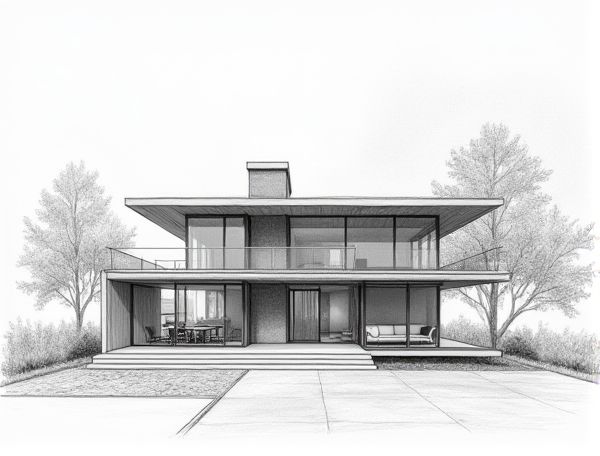
Photo illustration: Contemporary home design with reconfigurable smart glass walls
Contemporary home design embraces innovation by integrating reconfigurable smart glass walls that offer customizable privacy, natural light control, and seamless indoor-outdoor transitions. Explore how Your living space can be transformed with these adaptive features by reading more in the article.
Introduction to Contemporary Home Design Trends
Contemporary home design trends emphasize clean lines, open floor plans, and the use of sustainable materials such as reclaimed wood and low-VOC paints to create eco-friendly living spaces. Incorporating smart technology and multifunctional furniture enhances both functionality and aesthetic appeal in modern homes.
The Rise of Reconfigurable Smart Glass Walls
Reconfigurable smart glass walls transform your living space by allowing dynamic control over light, privacy, and aesthetics through electrochromic or thermochromic technologies. These innovative walls enhance energy efficiency, adaptability, and modern design, creating versatile environments tailored to your lifestyle and needs.
How Smart Glass Technology Works
Smart glass technology uses electrochromic, photochromic, or thermochromic materials to adjust transparency by applying an electric voltage, changing heat, or reacting to light. This dynamic control enhances energy efficiency and privacy by regulating natural light and heat entry in home environments.
Benefits of Reconfigurable Glass Walls in Modern Living
Reconfigurable glass walls enhance modern living by offering flexible space division and maximizing natural light penetration, which improves energy efficiency and indoor ambiance. Their modular design allows homeowners to easily adapt room layouts to changing needs without compromising aesthetic appeal or structural integrity.
Energy Efficiency and Sustainability Impacts
Incorporating energy-efficient materials such as insulated windows, solar panels, and LED lighting significantly reduces household energy consumption, lowering utility costs and carbon footprints. Sustainable design strategies like passive solar heating, green roofs, and rainwater harvesting promote resource conservation and enhance indoor environmental quality. Prioritizing these features in home design supports long-term ecological balance while increasing property value and occupant comfort.
Enhancing Natural Light and Privacy
Maximizing natural light in your home can be achieved by installing large, strategically placed windows and using light-reflective interior colors that amplify sunlight. To preserve privacy without sacrificing brightness, consider using frosted glass, sheer curtains, or smart window films that allow light in while blocking views from outside. Incorporating these design elements optimizes both ambiance and seclusion, creating a comfortable and well-lit living space.
Seamless Indoor-Outdoor Transitions
Seamless indoor-outdoor transitions enhance home design by integrating spacious sliding glass doors and consistent flooring materials that create a fluid connection between living spaces and outdoor areas. Incorporating retractable walls and natural lighting further amplifies the sense of openness, promoting a harmonious blend of comfort and nature.
Smart Home Integration with Glass Wall Systems
Smart home integration with glass wall systems enhances your living space by combining advanced automation and sleek, transparent architecture. These systems offer voice-activated controls, customizable lighting, and temperature regulation that seamlessly blend with the modern aesthetic of glass walls. By integrating smart technology, your home achieves both energy efficiency and a cutting-edge design that adapts to your lifestyle.
Design Considerations and Customization Options
Design considerations in home designing include spatial layout, natural lighting, and material selection to enhance functionality and aesthetic appeal. Customization options such as adjustable shelving, modular furniture, and smart home integration allow personalized living spaces tailored to individual lifestyles. Prioritizing ergonomic design and sustainable materials ensures comfort and environmental responsibility.
Future Innovations in Smart Glass for Homes
Smart glass technology is rapidly evolving with features like dynamic tinting, energy-efficient insulation, and integrated solar panels that transform your home's windows into multifunctional, adaptive surfaces. These innovations enhance privacy, reduce energy consumption, and contribute to sustainable living, positioning smart glass as a cornerstone in the future of home design.
 homedesy.com
homedesy.com